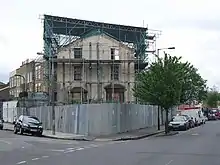William Lyttle
William Lyttle (1931–2010) was a British civil engineer notable for digging an extensive network of tunnels under his home in London.[1]
_(98091571).jpg.webp)
Excavation
Lyttle, originally from Ireland, inherited a 20-room property in the London borough of Hackney. In the mid-sixties he dug out a wine cellar under his home. Having done so, he said that he had "found a taste for the thing" and kept on digging, for some forty years.[2] He created a network of tunnels, wide and narrow, on several levels. Tunnels led in all directions, some of them up to 18 metres (59 ft) in length, and reaching as far down as the water table.[3] One excavation connected with the Dalston Lane tunnel, and the railway line.[3]
Lyttle dumped the clay he dug up in his garden and sometimes in empty rooms of the house.[2] At some point, he stopped maintaining his house and the building fell into disrepair.
Lyttle's work attracted complaints from neighbours when sinkholes began to appear in the pavement,[2] and when water and power supplies were interrupted.[4] The local pub also expressed concern that its cellar could collapse into one of Lyttle's tunnels.[4] Serious complaints to Hackney Council may have started around the turn of the century, leading to inspections but at first not to firm actions. Because of the state of the house and the complaints an ultrasound inspection was carried out in 2006, revealing the extent of the tunnels.[5]
When asked by journalists why he had excavated the tunnels, he said "I'm just a man who loves to dig" and that he just wanted "a big basement".[6] He also said that "There is great beauty in inventing things that serve no purpose."[6]
Lyttle was dubbed "The Mole Man of Hackney" by the press.[1]
Legal challenges
Lyttle was evicted in 2006,[5] and Hackney Borough Council filled the tunnels with aerated concrete.[3] He contested the decision in court and returned to his home for a short time.[2] In 2008, the High Court of Justice ordered that Lyttle cover the costs of the council making the structure safe, at a total of £293,000.[7]
After this, Lyttle was moved to a hotel for three years, before being rehoused in an apartment in a high-rise building. He was put on the top floor, to discourage tunnelling.[6] While there he knocked a hole in a dividing wall between two rooms.[7]
Property after Lyttle

Some 33 tonnes of soil and debris were removed from Lyttle's former garden and from some of the rooms, including the wrecks of three cars and a boat.[8] In 2012 the property was sold for £1.1 million.[1] By 2020, the house had been renovated by the architect David Adjaye to form a home and studio for the artist Sue Webster.[9]
See also
Sources
- 'Mole Man' home in Hackney sold for £1.12m, BBC, 19 June 2012.
- Great London Eccentrics: The Mole Man Of Hackney, Londonist, August 2015.
- "How Artist Sue Webster Transformed Hackney's Mole Man House And Its Labyrinthine Underground Warren". British Vogue. Retrieved 5 June 2020.
- Sinclair, Iain (2010). Hackney, That Rose-Red Empire: A Confidential Report. Penguin Adult. ISBN 978-0-14-101274-2.
- After 40 years' burrowing, Mole Man of Hackney is ordered to stop, The Guardian, 8 August 2006.
- Hunt, Will (2019). Underground. Simon & Schuster UK. ISBN 978-1-4711-3959-8. Retrieved 5 June 2020.
- Meanwhile, the 'human mole' bites the dust, The Independent, 19 June 2010.
- Mole Man of Hackney leaves council in a £350,000 hole, London Evening Standard, 18 June 2010.
- "David Adjaye renovates Mole House undermined by illegal secret tunnels". Dezeen. 4 February 2020. Retrieved 4 February 2020.